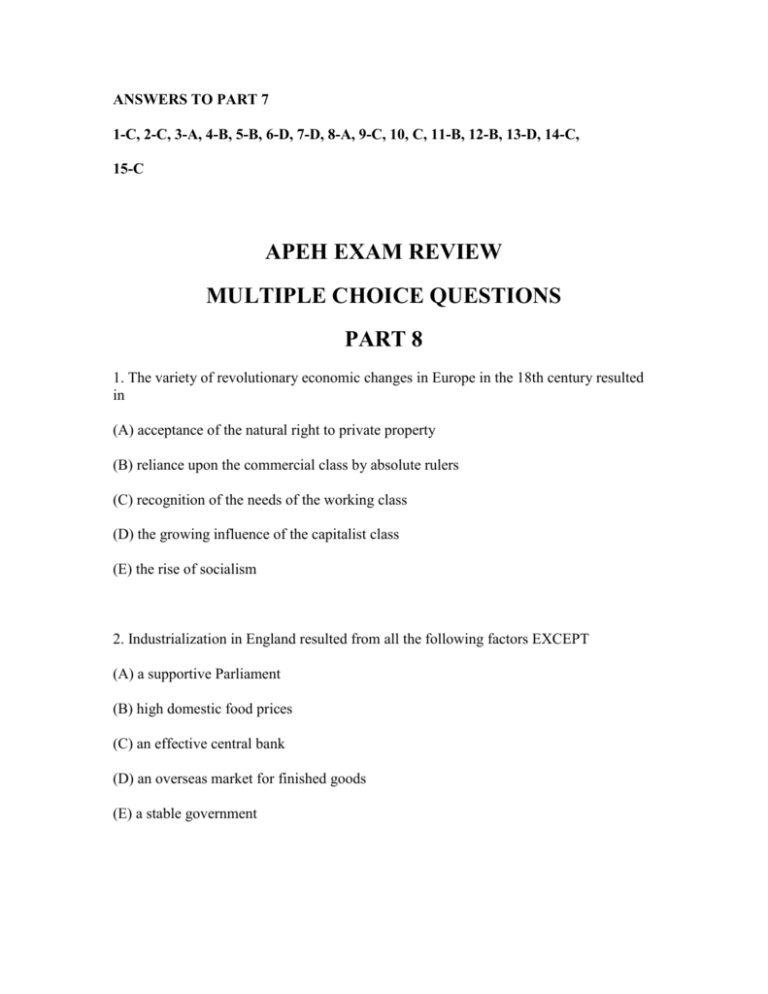apeh exam review multiple choice questions part 8
advertisement

ANSWERS TO PART 7 1-C, 2-C, 3-A, 4-B, 5-B, 6-D, 7-D, 8-A, 9-C, 10, C, 11-B, 12-B, 13-D, 14-C, 15-C APEH EXAM REVIEW MULTIPLE CHOICE QUESTIONS PART 8 1. The variety of revolutionary economic changes in Europe in the 18th century resulted in (A) acceptance of the natural right to private property (B) reliance upon the commercial class by absolute rulers (C) recognition of the needs of the working class (D) the growing influence of the capitalist class (E) the rise of socialism 2. Industrialization in England resulted from all the following factors EXCEPT (A) a supportive Parliament (B) high domestic food prices (C) an effective central bank (D) an overseas market for finished goods (E) a stable government 3. Which of the following was most important in changing the textile industry? (A) low cost American cotton (B) the "piece goods" domestic system (C) labor saving machinery in large mills (D) permitting child labor within factories (E) the development of water power 4. James Hargreaves and Richard Arkwright were both associated with (A) machine tools (B) textile-spinning machines (C) railroad equipment (D) steam engines (E) agricultural machinery 5. The British Factory Act of 1833 (A) restricted the number of hours of permitted work (B) raised wages dramatically (C) provided compensation for disabled workers (D) prohibited the employment of children under 9 years old (E) provided sanitary working conditions 6. The 1852 lithograph above entitled "Cockerill's Works" intended to display the (A) apocalypse resulting from the effects of industrialization (B) environmental damage wrought by the factory system (C) awesome power of the new industrial technology (D) arduous result of round the clock shifts (E) benefits produced by the new steam technology 7. The English Luddites were workers who (A) demanded better pay and working conditions (B) anti-industrialists who destroyed machines (C) were utopian socialists (D) fought for greater representation in Parliament (E) unionized British industry 8. The Chartists demanded (A) a suffrage for the working class (B) elimination of tarriffs on imports (C) free trade for entrepreneurs (D) repeal of the Corn Laws (E) collective bargaining 9. The lack of industrialization of Continental Europe before 1815 is BEST explained by (A) setbacks caused by the French revolution and Napoleonic wars (B) the small scale of enterprises on the Continent (C) the scarcity of raw materials (D) the lack of skilled labor (E) ineffective transportation systems 10. Industrialization of Continental Europe after 1815 resulted from all the following EXCEPT (A) the removal of numerous tarnffs (B) population increases in developed nations (C) state intervention to stimulate industry (D) increased technical advice from England (E) improved roads, bridges, and railroads 11. Which of the following industries in France and Belgium gained an international reputation during the reign of Louis XIV? (A) Silk and lace (B) Railroads (C) Iron and steel (D) Mining (E) Coal 12. Which of the following was a customs union, reducing tarriffs among its members? (A) Credit Mobilier (B) Societe Generale (C) Zollverein (D) Continental System (E) Le Fisc 13. The prerequisites of an industrial revolution include all the following EXCEPT (A) a fully developed transportation system (B) markets for the sale of goods (C) rigid governmental regulation of the economy (D) a commercial class of entrepreneurs (E) a viable source for raw materials 14. The economic position of the working class is BEST described in which statement? (A) Population increase brought unemployment and poverty. (B) The availability of cheaper food eliminated hunger. (C) Typhus, tuberculosis, and cholera were eliminated. (D) Welfare programs in the cities were funded by local governments (E) Private charities greatly allieviated hunger and distress. 15. Of the following, which was NOT a major problem for the working class in the 1850's? (A) Absence of affordable housing (B) Availability of unskilled jobs (C) Improvement of public sanitation (D) Affordable public transportation (E) Adequate health care 16. Prostitution in the late 19th century generally was (A) decreasing (B) remaining constant (C) increasing (D) regulated (E) illegal 17. In the late 19th century, married middle class women were (A) treated as equals with their husbands (B) given greater control over their families (C) excluded from family finances (D) totally subservient to their husbands (E) encouraged to pursue independent careers 18. In his The Condition of the Working Class in England in 1844, Friedrich Engels accused which class of exploiting the workers? (A) Landed gentry (B) Aristocrats (C) Middle class (D) Nobility (E) Monarchy







